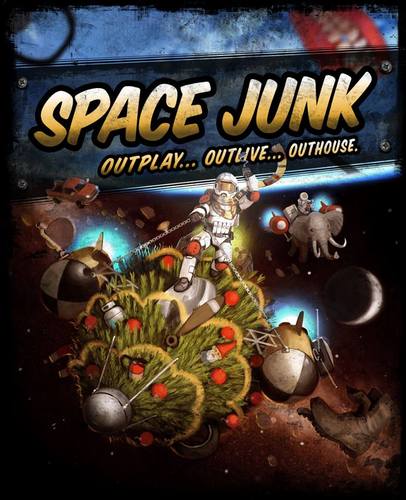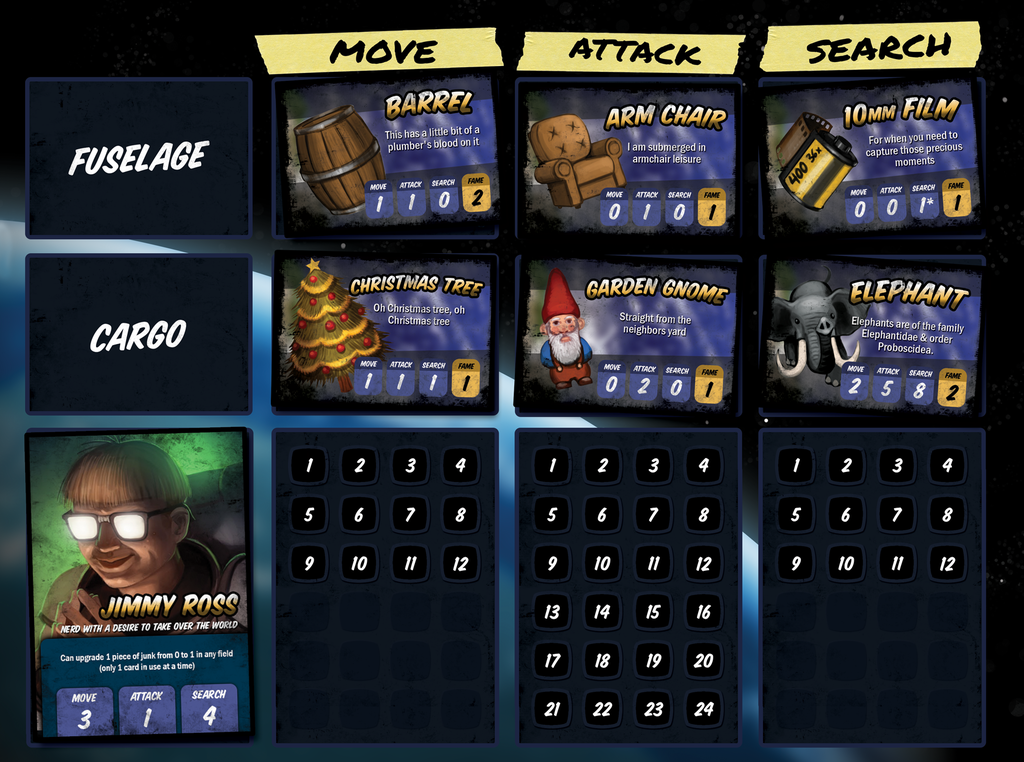Normally when I play a sci-fi themed game, I’m blowing up Klingons or launching proton torpedoes at some unsuspecting TIE Fighter. “Space Junk” takes a different approach and tasks players with collecting the most fame by collecting…you guessed it, junk. Junk can also be used to upgrade your ship across three stats: movement, attack, and search and can also be lost in battle. Hope you’re ready to think like Neelix from Star Trek: Voyager, but we’re about to scrounge!

Space Junk: 2-6 Players, Ages 8+, Average Play Time = 30-60 Minutes
Setup & Gameplay
To give you an overview of setup, each player gets a random character card to put on their personal board. Some characters start with a space junk card, so search and pull stuff out of the junk deck as you need to and shuffle. Players place their ships (large cubes) on the start line and score cubes (little cubes) near the tracker. The other three smaller cubes are placed on the three different categories (one per category) to track an individual stat (movement, attack, or search).
If you have two cards on your board with an attack of 1 and another with an attack of 2, then the cube under the attack tracker would start at 3. It’s important to note that throughout the game, junk cards placed under the movement, attack, and search columns observe that stat only when adjusting these trackers. All three stats on the character card and fuselage space are observed. Someone receives the first player token to go first, though it passes clockwise every round.
The game is played over six rounds. The round is broken up into three phases, with each player performing the phase before everyone moves onto the next one.
1. Movement – The active player chooses one of the three rings (moving their ship cube back a bit when moving further out due to the increased frequency of spaces) and moves the number of spaces listed on their movement tracker. The blue ring has four spaces whereas as yellow and red are further out and have more. Each time a ship crosses the start line, the player earns five points.
2. Attack – The active player chooses a target and rolls one D6. They add the value of the roll to their attack value minus the number of spaces to their target. Then, for every 5 they can squeeze into the total value without going over, they score a hit. If the final value is 13, then they’d score two hits. For every hit, they score three points AND roll that many D6 to determine damage to the other ship. Each of the six spaces on a player board (two under each movement/attack/search) column has a number assigned to it and any numbers rolled will damage that junk card, which can still be used but is discarded during the search phase.
3. Search – The active player draws a number of junk cards based on their search value and their maximum draw limit based on which ring they’re in. You’re limited to three cards in the blue ring, for example, even if your search stat is 5. They can then add these cards to their board, adding/replacing cards or piling them into their safe cargo hold if they so choose.
After six rounds, players also take into account any fame they may have on any of their cards, whether they come from their cargo or other spaces. Points are tallied and whoever has the most, wins!
Editor’s Note: The above doesn’t cover all of the rules found in the manual, but should give you an idea as to how the game is played.

The Review
“Space Junk” is a pretty cool idea and most certainly easy on the eyes graphically. Vinnie Jr. and I had two completely different approaches and it turned out, he won by a landslide despite me being ahead most of the game. My character had a high movement value and low attack/search values, so I kept lapping the blue ring which only has four spaces. I scored the majority of my points this way, while Vinnie kept pounding at me with a high weapon’s value and earned three points with every hit. I eventually had to store anything with fame points into my cargo hold because anything on the six stat spaces kept getting destroyed. He later upgraded his search stat and moved to the red ring where he could draw an insane amount of cards which, through fame, won him the game.
What this game lacks is a manual the explains some of the concepts well. The black first player disc isn’t mentioned anywhere in the components section and there’s a gnome (?) in place of the 6 on the dice…don’t know why, but there is. I looked for some sort of special power related to this die face, but couldn’t find one. To me, it seems like the manual was half-baked…as if someone shrugged their shoulders and said, “eh, good enough”. Despite my issues with the rulebook, I would come back to this game just to see what kind of junk I’d draw next. The deck is HUGE, so there’s no way you’d be able to see everything in one sitting…hence, replayability.
I picked it up while it was on sale through the Miniature Market for about $12 and I don’t regret my purchase. I believe the MSRP is much higher, roughly $35-$40 or so, but don’t quote me on it. Amazon’s currently selling it for $17, down from $42, if the list price can be trusted.
Final Verdict: 7/10
—
